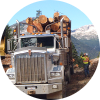Forestry is a complex undertaking, especially on the coast. To address these challenges the following approaches will be used.
Resource Management Conflicts
Forestry is a controversial undertaking and given the close proximity of the operating areas to the community and the multitude of resource users, there is potential for resource use conflict. The larger land use issues in the Mid Coast have been resolved through the Central Coast Land and Resource Management Plan creating a more stable operating environment. The anticipated main issues of potential conflict for the community forest are visual aesthetics and mushroom picking. However, with the community forest being a run by a local company, it is anticipated that solutions acceptable to the community can be more readily achieved. The BCCF will maintain a local office making the company accessible to people with concerns and it will routinely provide information to the community about its intended plans. The Advisory Committee will also provide guidance on minimizing resource use conflicts.
Profitability
The poor financial performance of the coastal forest industry has been widely reported and the many variables associated with logging (weather, complex machinery, operating conditions, environmental factors, volatile markets, delays in transportation, etc) makes the community forest enterprise a risky financial endeavour. As indicated, the average value of the timber inventory is significantly less than the anticipated harvesting costs and therefore higher than average value stands will have to be targeted for harvest in the short term. Innovative
processing, utilization and marketing strategies will also be needed to increase stand value over time, while working to reduce costs.
Financial risk will be minimized through :
- tight financial control
- careful operational planning
- minimal investment in machinery or infrastructure
- contracting of all phases
- development of financial pro-formas for each new road and cutblock and
- only operating when economic conditions are favourable
General Liability
The enterprise faces the typical liability risks associated with most industrial activity. The main areas of potential liability are :
- Injury to third party or workers
- Environmental damage (landslide, stream pollution)
- Contravention of legal permits
- Fire
- Damage to third party infrastructure.
To guard against exposure to liability, contractual arrangements will be structured to limit transferability of liability to the BCRS and the BCCF Company. However, the main approach to reduce risk of liability is to implement a due diligence program through a Safety and Environmental Management System.
Roads and Silviculture
The main long term liabilities associated with forest tenures are the reforestation of harvested areas and maintenance/deactivation of roads. To minimize these liabilities, roads will be designed by qualified engineers and terrain stability specialists and reforestation plans will be developed by professional foresters prior to areas being logged. A formal system of monitoring and documentation will be employed whereby each cutblock, road, culvert and bridge is regularly inspected to ensure compliance with standards. Funds will be retained to cover future silviculture or road liabilities.
Nuxalk Nation
The community forest is located in primarily Nuxalk Nation territory and the community forest is committed to working with the Nuxalkmc for the benefit of the whole Bella Coola valley community. The community forest is committed to working with the Nuxalk Nation’s forestry enterprise to increase efficiency and reduce costs by ‘piggy backing’ operations together as much as possible.



